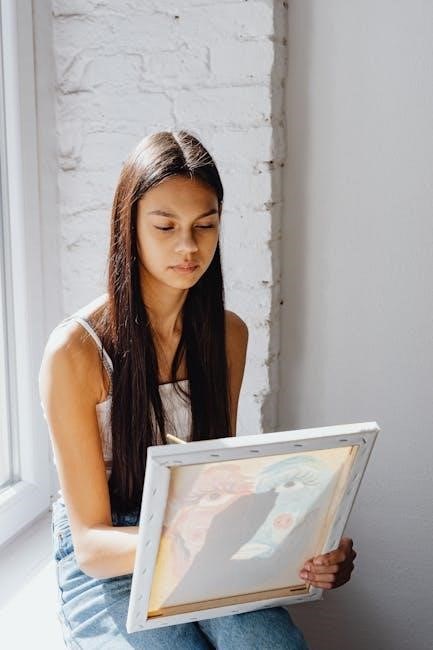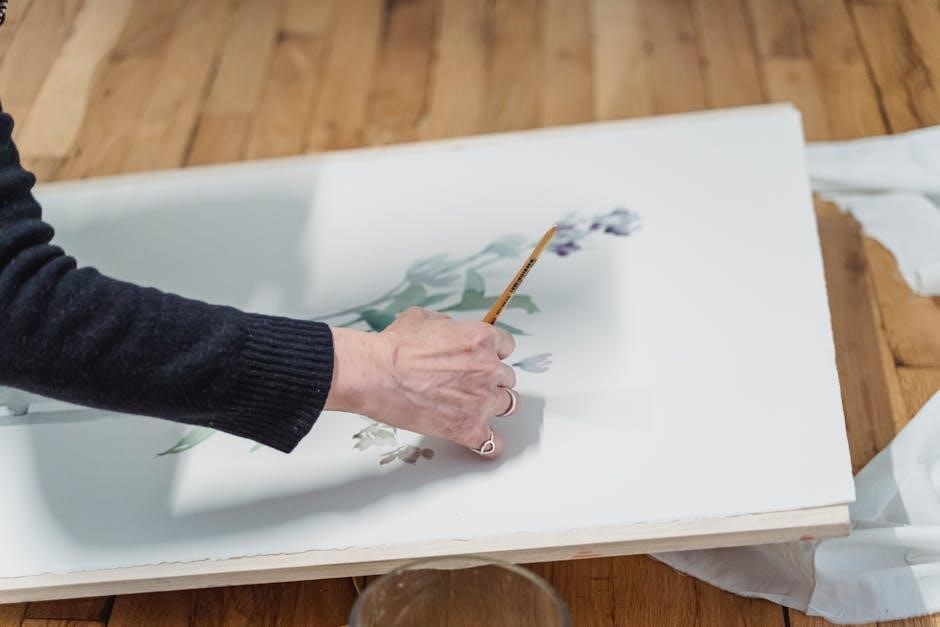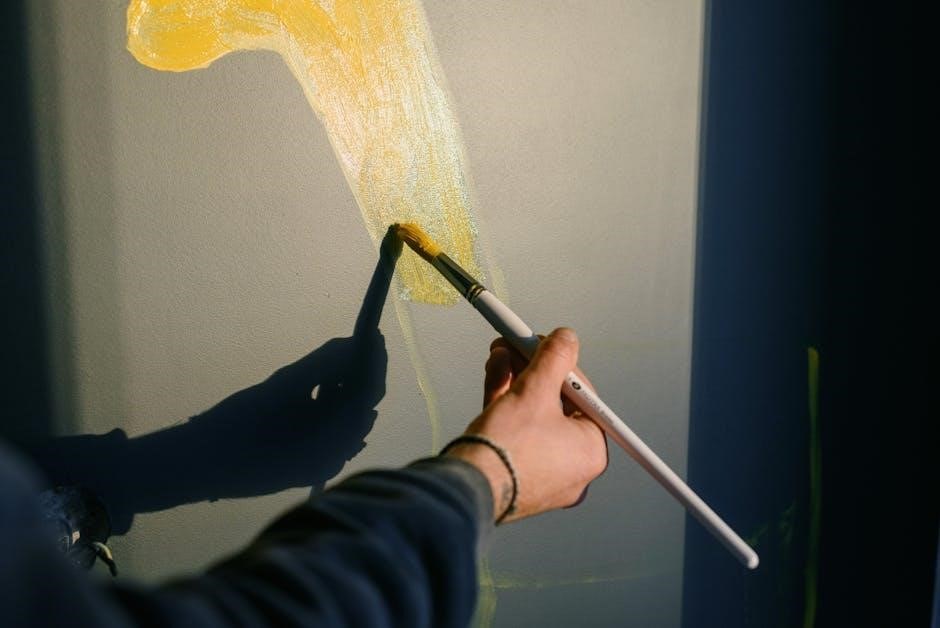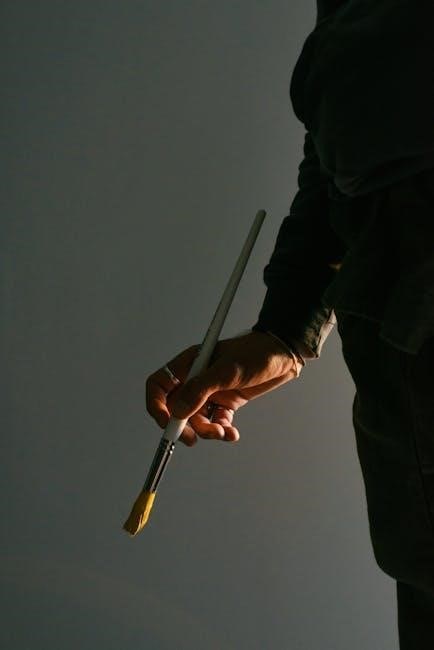Color and light are fundamental to realist painting, bridging artistic observation with scientific principles. James Gurney’s approach offers practical techniques for mastering these elements, enhancing visual realism.
The Importance of Color and Light in Realism
Color and light are essential tools for creating realistic paintings, as they define form, depth, and atmosphere. Light reveals textures and volumes, while color conveys mood and context. Together, they guide the viewer’s perception, making scenes appear lifelike. Understanding their interplay is crucial for capturing authenticity in realist art, allowing artists to manipulate emotions and focus attention effectively.
Overview of James Gurney’s Approach
James Gurney’s approach to color and light emphasizes bridging theory with practice, blending scientific principles with artistic observation. His method, detailed in “Color and Light,” provides practical guidance on light sources, color mixing, and visual perception. Gurney’s techniques help artists achieve realistic effects, focusing on understanding light’s behavior and color’s emotional impact. His approach is both accessible and comprehensive, making it invaluable for artists seeking to enhance their realism skills.

Understanding Light and Its Properties
Light reveals form, creates shadow, and defines structure, while its properties like intensity, direction, and color temperature influence the visual impact in realist painting.
Natural Light Sources and Their Effects
Natural light, such as sunlight and moonlight, significantly influences color and form in realist painting. Direct sunlight creates sharp shadows and vivid contrasts, while diffuse light softens edges. Overcast skies produce cooler tones and reduce dramatic shadows. The color temperature of natural light varies, with sunlight being warmer at sunrise and sunset, affecting how pigments appear. Observing these effects helps artists accurately capture realistic lighting in their work, enhancing depth and authenticity.
Artificial Light Sources and Their Characteristics
Artificial light sources, such as lamps, candles, and LED lights, offer unique qualities for realist painting. Incandescent bulbs emit warm, yellowish tones, while fluorescent lights produce cooler, bluish hues. LEDs provide bright, neutral illumination. These sources create distinct shadows and highlights, altering color perception. Warm lighting can evoke coziness, while cool tones may feel stark. Artists must study how artificial light interacts with pigments to capture realistic effects, as these sources often accentuate or mute specific hues, adding depth to a scene.
The Interaction of Light and Form
Light reveals form by creating highlights, mid-tones, and shadows, defining three-dimensional structure. The interaction of light with surfaces emphasizes texture, volume, and depth. As light moves, it shapes the visual narrative, guiding the viewer’s eye. Understanding this relationship allows artists to convey realism, as light transforms flat forms into dynamic, lifelike subjects. The subtle transition of values, from light to dark, captures the essence of form, making it a cornerstone of realist painting techniques.
The Fundamentals of Color Theory
Color theory forms the foundation of realist painting, enabling artists to manipulate mood, depth, and focus. The color wheel guides harmony and contrast, essential for realistic depictions.
Color Relationships: Harmony and Contrast
Understanding color relationships is crucial for realist painters. Harmony creates unity, while contrast adds visual interest. Using complementary colors enhances vibrancy, and analogous colors build cohesion. James Gurney explains how these principles can be applied effectively in painting to achieve balance and depth. By mastering these techniques, artists can guide the viewer’s eye and evoke emotions through their work.
The Color Wheel and Its Applications
The color wheel is a vital tool for understanding color theory. It displays primary and secondary colors, illustrating how they relate. Warm colors like red and orange evoke energy, while cool colors like blue and green create calm. The wheel helps artists mix pigments effectively and create harmonious color schemes. James Gurney emphasizes its practical use in painting, enabling realist artists to achieve balance and evoke specific moods through thoughtful color selection and application.
Local Color and Its Role in Painting
Local color refers to the true color of an object under specific lighting. It is the foundation for realistic painting, as it captures the essence of the subject’s surface. Understanding local color helps artists create accurate representations, especially when considering variations in light and shadow. By mastering this concept, painters can enhance their work’s depth and authenticity, ensuring that each element appears lifelike and three-dimensional. This approach is essential for achieving the realism that defines James Gurney’s teachings on color and light.

Pigments and Paints
Pigments are the essence of painting, offering a spectrum of hues. Understanding their properties, lightfastness, and mixing capabilities is crucial for achieving desired colors and effects in realist art.
Understanding Pigment Properties
Pigments vary in lightfastness, opacity, and texture, influencing their behavior in mixtures. Some, like earth oxides, are durable and opaque, while others, such as lake pigments, are translucent. Understanding these properties helps artists predict color shifts and maintain consistency. James Gurney emphasizes the importance of selecting pigments that align with the desired visual effects, ensuring longevity and vibrancy in realist paintings. This knowledge allows artists to harness the full potential of their materials, creating rich, enduring works of art.
Mixing Colors: Theory and Practice
Mixing colors effectively requires both theoretical understanding and practical skill. James Gurney emphasizes the importance of premixing colors to achieve harmony and consistency. By creating a “color string” of gradated values, artists can streamline their process and maintain visual coherence. This method, along with an awareness of pigment properties, allows for precise control over chroma and value, ensuring that color mixtures align with the observed light and form in a painting. This approach bridges theory and practice, enabling realist painters to achieve authentic and captivating results.
The Role of Pigments in Realist Painting
Pigments are the foundation of realist painting, offering a wide range of hues and textures. Understanding their properties, such as opacity, transparency, and lightfastness, is crucial for achieving realistic effects. Gurney highlights the importance of local color, the true color of an object under white light, and how pigments interact with light to create depth and dimension. By mastering pigment behavior, artists can craft lifelike, immersive imagery that captures the essence of their subjects with precision and emotional resonance.

Visual Perception and Psychology of Color
Color and light influence human perception and emotions, shaping how we experience art. Understanding these psychological effects enhances a painter’s ability to create impactful, realistic compositions.
How the Human Eye Perceives Light and Color
The human eye perceives light and color through the retina, where cones and rods detect wavelengths. Cones identify color, while rods handle low-light vision. Color constancy allows us to recognize hues under varying lighting. Gurney explains how these biological processes influence artistic techniques, emphasizing the importance of understanding perception to create realistic effects in painting.
Psychological Effects of Color in Art
Color profoundly influences emotions and moods, shaping the viewer’s experience. Warm hues like red and orange evoke energy and passion, while cool tones such as blue and green create calmness. Artists strategically use color harmony and contrast to guide attention and evoke specific feelings. Gurney highlights how color relationships can convey balance or tension, depending on their arrangement. This emotional impact underscores the importance of thoughtful color choices in realist painting to engage and connect with the audience effectively.
Surfaces and Effects
Surfaces and effects in realist painting involve understanding texture, light interaction, and material properties to create realistic renderings of various objects and environments.
Rendering Different Surfaces and Textures
Rendering different surfaces and textures requires a deep understanding of how light interacts with various materials. From smooth metals to rough fabrics, each surface reflects light uniquely. Artists must observe texture, sheen, and how light scatters or absorbs. Practical techniques like color strings help in capturing accurate tonal shifts. By studying the interplay of light and texture, painters can achieve lifelike representations of wood, stone, skin, and other materials, enhancing the realism in their work.
Creating Realistic Effects with Light and Color
Mastering realistic effects involves understanding light’s behavior on various surfaces. Observing how light interacts with different materials, from sharp highlights on metals to soft transitions on fabrics, is crucial. Utilizing techniques like color strings can help achieve smooth value transitions, enhancing depth. Studying light’s wrap-around effect on forms and applying principles like atmospheric perspective for distance can create three-dimensional illusions. Experimenting with pigments and their properties aids in capturing accurate hues, while visual perception insights refine color contrasts. Practice and observation are essential for translating these elements onto canvas, ensuring authentic representations of light and color in realist painting.

Atmospheric Effects and Distance
Atmospheric effects reveal how light interacts with the environment, softening colors and blurring details with distance. This creates depth, guiding the viewer’s eye through the composition naturally.
Painting Atmospheric Perspective
Atmospheric perspective captures the effect of light and distance on landscapes, softening details and cooling colors as objects recede. This technique creates depth by fading warm tones into blues and grays, simulating the atmosphere’s impact. Artists use layering and glazing to achieve these subtle shifts, enhancing realism. Understanding how light interacts with air and distance is crucial for conveying vast spaces and mood in realist painting, making scenes feel immersive and lifelike.
Light and Color in Distant Landscapes
In distant landscapes, light and color play a vital role in creating depth and atmosphere. As objects recede, their details soften, and warm tones transition to cooler hues, influenced by atmospheric perspective. This effect, often achieved through layering and glazing, mimics the scattering of light in the atmosphere. Artists must carefully observe how light interacts with varying distances to capture the essence of expansive scenes, ensuring that the illusion of depth and realism is maintained effectively in their work. This technique enhances the immersive quality of the painting.
Practical Exercises for Realist Painters
Practical exercises, such as color string and life painting, help artists master light and color. These techniques enhance observation and application, refining realist painting skills effectively.
Color String Exercises
Color string exercises involve creating a series of paint blobs in specific hues, mixed with a palette knife from light to dark values. This technique helps artists understand color relationships and value transitions. By observing how colors interact at different intensities, painters can refine their ability to capture light and shadow. These exercises also enhance the perception of chromatic grays and subtle shifts in tone. Regular practice improves color mixing accuracy and the ability to depict realistic lighting effects in paintings, making it a valuable tool for realist artists.
Painting from Life: Observing Light and Color
Painting from life is essential for mastering light and color. Observing real-world subjects allows artists to study how light interacts with forms, revealing subtle nuances in color and shadow. This direct approach enhances the ability to capture accurate color relationships and value transitions. By painting from life, artists develop a deeper understanding of local color and atmospheric effects, ultimately improving their skill in depicting realistic lighting and chromatic depth in their work. Regular practice fosters a keen eye for detail and a stronger connection to the subject matter.
Color and light are the heartbeat of realist painting, offering artists tools to capture reality and evoke emotion. Mastery of these elements elevates artistic expression and depth.
The Impact of “Color and Light” on Realist Painting
James Gurney’s “Color and Light” has revolutionized realist painting by bridging theory and practice. Its scientific yet accessible approach has made it a top seller, empowering artists to master light and color. The book’s insights into perception, pigments, and optical effects have raised the bar for realistic art, offering practical tools for capturing light and shadow. It has become a cornerstone for artists seeking to elevate their craft, proving indispensable for both beginners and seasoned painters.
Additional Resources for Further Study
For deeper exploration, artists can visit James Gurney’s blog, gurneyjourney.blogspot.com, which offers insights into color and light. Online tutorials, art forums, and workshops provide practical exercises. Libraries and art schools often host resources on realism and color theory. Engaging with fellow artists through communities like ConceptArt.org or ArtStation fosters learning and feedback. Additionally, exploring the works of masters and studying natural light in person can enhance understanding. These resources collectively enrich the journey of mastering realist painting techniques.
